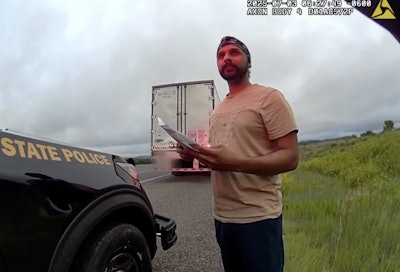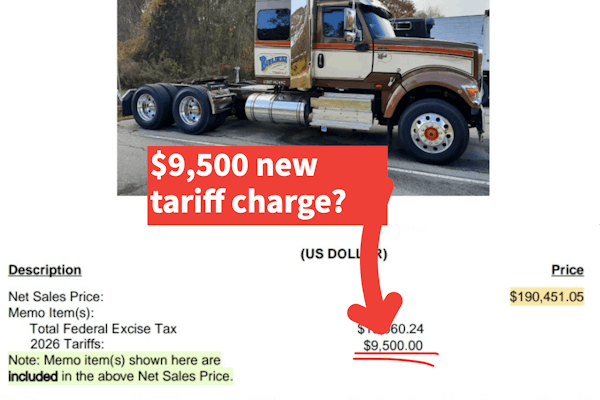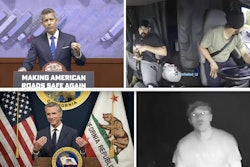
After New Mexico released bodycam footage of a traffic stop with Harjinder Singh, the driver whose triple-fatal Florida turnpike crash ignited a firestorm over foreign CDL drivers and English language proficiency, DOT doubled down, saying New Mexico's handling of the stop lead to "deadly results."
It's the latest salvo in a heated back and forth between DOT and three states -- California, Washington and New Mexico. It came after New Mexico disputed DOT's account of a July 3 traffic stop with Singh, complete with video evidence.
The episode highlights how difficult English language proficiency can be to consistently enforce.
DOT had accused New Mexico Tuesday of showing no willingness to comply with ELP enforcement and letting drivers with previous OOS orders go free. DOT went as far as saying it would pull up to $47 million in federal funding for the three states if they did not come into compliance within 30 days.
New Mexico State Police Chief Troy Weisler responded with his own account of seeking clarification from DOT on ELP enforcement, and said inspectors at roadside can't readily see if a driver has been put OOS. Furthermore, NMSP released bodycam video of the traffic stop with Singh that shows the driver communicating in English with the inspector throughout the stop.

On Wednesday, DOT shot back. "The claim that federal guidance on English Language Proficiency (ELP) was not provided to New Mexico is false," a spokesperson said. "On May 20, FMCSA issued clear, revised guidance for ELP inspections. Following that, the Commercial Vehicle Safety Alliance (CVSA) distributed this guidance to all states, including New Mexico."
The spokesperson added that the actions were taken "well in advance of the June 25 enforcement date, giving every state enough time to prepare."
Weisler previously said that when NMSP sought clarification about the new guidance on how to enforce ELP, "the response received was simply, 'You know when somebody doesn’t speak English.'"
The DOT spokesperson didn't dispute that, but pointed out that other states have been putting drivers OOS for ELP violations. "Our state enforcement partners have already removed more than 3,100 drivers from our roads for failing to meet this critical safety requirement," the spokesperson said.
"The failure here is not a lack of federal guidance but New Mexico’s inexplicable lack of enforcement, which has continued to allow drivers who cannot even understand road signs to operate commercial motor vehicles on America’s roadways without consequence—leading to deadly results," the spokesperson continued.
Digging into the bodycam footage itself (clip below to show only the conversations between Singh and the officer), DOT seemed to contradict itself.
Both at a press conference on Tuesday and in official guidance, FMCSA said to initiate an ELP assessment only if a driver fails to initially communicate in English. Here how it's stated in the guidance issued in June: "If the inspector’s initial contact with the driver indicates that the driver may not understand the inspector’s initial instructions, the inspector should conduct an ELP assessment in order to evaluate the driver’s compliance with 49 CFR § 391.11(b)(2)."
FMCSA Chief Counsel Jesse Elison, speaking at a press conference Tuesday, said the ELP assessment "only is triggered when there is a challenge to communicate" between the driver and inspector.
NMSP's bodycam footage is a little hard to hear due to the idling truck and road noise, but the conversation proceeds at a normal pace, with the officer making a few document requests and Singh responding in English.
At the conclusion of the stop, after the officer has already cited Singh for speeding there is a bit of confusion as Singh struggles to ask how long the violation will stay on his record.
After Singh speaks unintelligibly for a moment about his license and the ticket, the officer says, "I’m sorry, I guess I don’t understand what you’re saying."
Singh responds something like: "This my ticket, and on my license, how many years?"
The officer understand this time, and tells Singh: "Don't quote me on this but I think anywhere from five to seven years."
Singh then accepts his response and the interaction ends.
According to DOT, that one garbled passage of conversation should have triggered the ELP assessment. From the DOT spokesperson:
"The traffic stop in New Mexico is a clear example of why nationwide enforcement is necessary The officer’s own words in the video, 'I’m sorry, I guess I don’t understand what you’re saying,' document a clear communication breakdown demonstrating the driver’s inability to understand the officer’s basic instructions. The driver’s inability to communicate with the officer should have immediately triggered an ELP assessment as outlined in the guidance, which did not occur because the state of New Mexico’s refusal to enforce ELP."
DOT previously reported that an FMCSA ELP assessment administered after the Florida crash found Singh "failed the assessment, providing correct responses to just two of 12 verbal questions and only accurately identifying one of four highway traffic signs."
[Related: DOT threatens funding for California, Washington, New Mexico over lax ELP enforcement]











